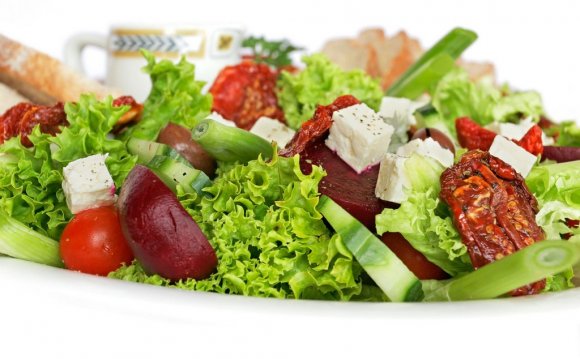
 It's easier than you think to start eating healthy! Take small steps each week to improve your nutrition and move toward a healthier you.
It's easier than you think to start eating healthy! Take small steps each week to improve your nutrition and move toward a healthier you.
Eight Healthy Eating Goals
Small changes can make a big difference to your health. Try incorporating at least six of the eight goals below into your diet. Commit to incorporating one new healthy eating goal each week over the next six weeks. You can track your progress through PALA+.
Make half your plate fruits and vegetables: Choose red, orange, and dark-green vegetables like tomatoes, sweet potatoes, and broccoli, along with other vegetables for your meals. Add fruit to meals as part of main or side dishes or as dessert. The more colorful you make your plate, the more likely you are to get the vitamins, minerals, and fiber your body needs to be healthy.
Make half the grains you eat whole grains: An easy way to eat more whole grains is to switch from a refined-grain food to a whole-grain food. For example, eat whole-wheat bread instead of white bread. Read the ingredients list and choose products that list a whole-grain ingredients first. Look for things like: "whole wheat, " "brown rice, " "bulgur, " "buckwheat, " "oatmeal, " "rolled oats, " quinoa, " or "wild rice."
 Switch to fat-free or low-fat (1%) milk: Both have the same amount of calcium and other essential nutrients as whole milk, but fewer calories and less saturated fat.
Switch to fat-free or low-fat (1%) milk: Both have the same amount of calcium and other essential nutrients as whole milk, but fewer calories and less saturated fat.
Choose a variety of lean protein foods: Meat, poultry, seafood, dry beans or peas, eggs, nuts, and seeds are considered part of the protein foods group. Select leaner cuts of ground beef (where the label says 90% lean or higher), turkey breast, or chicken breast.
Compare sodium in foods: Use the Nutrition Facts label to choose lower sodium versions of foods like soup, bread, and frozen meals. Select canned foods labeled "low sodium, " "reduced sodium, " or "no salt added."
Drink water instead of sugary drinks: Cut calories by drinking water or unsweetened beverages. Soda, energy drinks, and sports drinks are a major source of added sugar and calories in American diets. Try adding a slice of lemon, lime, or watermelon or a splash of 100% juice to your glass of water if you want some flavor.
Eat some seafood: Seafood includes fish (such as salmon, tuna, and trout) and shellfish (such as crab, mussels, and oysters). Seafood has protein, minerals, and omega-3 fatty acids (heart-healthy fat). Adults should try to eat at least eight ounces a week of a variety of seafood. Children can eat smaller amounts of seafood, too.
Cut back on solid fats: Eat fewer foods that contain solid fats. The major sources for Americans are cakes, cookies, and other desserts (often made with butter, margarine, or shortening); pizza; processed and fatty meats (e.g., sausages, hot dogs, bacon, ribs); and ice cream.
 Try This!
Try This!
Emphasis on Fruits & Veggies
- Mix vegetables into your go-to dishes. Try spinach with pasta or peppers in tacos.
- Use fresh, frozen, and canned fruits and vegetables. They all offer the same great nutrients. Just be sure to watch the sodium on canned vegetables and look for fruits packed in water or 100% juice (not syrup).
- Pack your child's lunch bag with fruits and veggies: sliced apples, a banana, or carrot sticks are all healthy options.
Healthy Snacks
- For a handy snack, keep cut-up fruits and vegetables like carrots, peppers, or orange slices in the refrigerator.
- Teach children the difference between everyday snacks, such as fruits and veggies, and occasional snacks, such as cookies or other sweets.
- Make water a staple of snack time. Try adding a slice of lemon, lime, or a splash of 100% juice to your water for a little flavor.
- Swap out your cookie jar for a basket filled with fresh fruit.
Ways to Reduce Fat, Salt, and Sugar
- Choose baked or grilled food instead of fried when you're eating out and implement this at home, too.
- Make water and fat-free or low-fat milk your go-to drinks instead of soda or sweetened beverages.
- Serve fruits as everyday desserts—like baked apples and pears or a fruit salad.
- Read labels on packaged ingredients to find foods lower in sodium.
- Skip adding salt when cooking; instead use herbs and spices to add flavor.
 Controlling Portion Size
Controlling Portion Size
- Use smaller plates to control portion sizes.
- Don't clean your plate or bowl if you're full, instead save leftovers for tomorrow's lunch.
- Portion sizes depend on the age, gender, and activity level of the individual.
Healthy Eating in School
- Bring healthy snacks into your child's classroom for birthday parties and celebrations, instead of providing sugary treats.
- Pack healthy lunches for your children including whole grains, fruits and vegetables, and fat-free or low-fat dairy products.
Tips from Council Members
As a father, I know that kids can be picky eaters so I try to lead by example by trying new foods. We use cookie cutters to make fun shapes with fruits and veggies (like watermelon and peppers) and they love it!
Be aware of what you're eating. Nutritionally, I've become an avid label reader and make sure to increase my fruits and vegetable consumption.
The spice cabinet is an easy (and all-weather) way to add flavor, but in summer, I like to take advantage of fresh herbs. The usual suspects: basil, rosemary, tarragon—but also the unexpected, like lemon thyme or pineapple sage. They'll add delicious aroma and depth to everything from iced tea to ice cream.
Make sure you eat well so that you have enough energy to perform at your best. Also, replenish your body with water after any activity.
Turn the TV off and come together as a family for mealtime. You will get to spend time with the kids while modeling healthy eating habits.
Many smart phone apps are available to help you navigate restaurant options and make healthier choices. MyPlate is one of my (free!) favorites.
Pack healthy snacks: A few of my favorites are clementines, bananas, apples, and pears (if you are flying, unpeeled fruit is OK through airport security), whole-grain crackers and cereal, and dried fruit and nuts (in small amounts as the calories can add up).
I always make sure that I have a healthy snack in my purse, backpack, or gym bag, and make sure to carry a bottle of water with me. Being prepared is the best way to avoid eating junk food or other temptations. Whether it's at work, school, or gym you need to make sure that you have something healthy to snack on and plenty of water to stay hydrated.
Tips for Balancing Calories to Manage Weight
Following the eight healthy eating goals above can help your body get the nutrients it needs. Here are some other tips to keep in mind if you also are trying to manage your weight.


INTERESTING VIDEO












